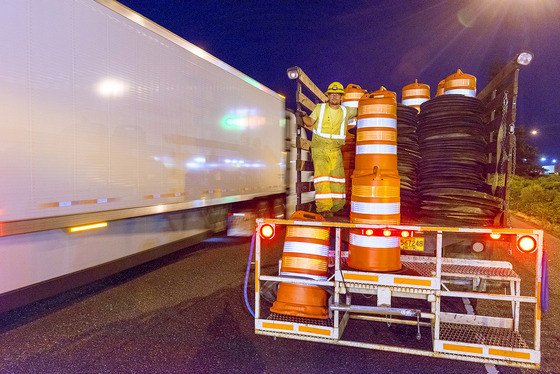With NW work zone fatalities on the rise, DOT workers struck by drivers plead for careful, attentive driving

National Work Zone Awareness Week begins next Monday
PORTLAND, Ore. (KTVZ) -- After work zone fatalities in Washington state doubled in 2023 from the previous year, state agencies from both sides of the Columbia River are coming together to revitalize their focus on driver safety in and around work zones.
On Thursday, the Oregon Department of Transportation and the Washington State Department of Transportation gathered state leaders, law enforcement officials and workers struck by drivers in work zones to ask the public to drive more carefully and attentively.
A work zone is typically characterized as an area where road crews are present and active. Road signs alert drivers that they are approaching an active work zone. Along with state employees, roadside workers also include local city or county road crews, tow truck drivers, contractors, emergency responders, and law enforcement officers.
All roadside workers are spouses, partners, parents, children, siblings or friends to someone – and they all deserve to get home safely at the end of their shift.
It is not just road crews at risk in work zones: Nearly 95% of people injured in work zone crashes are drivers, their passengers or nearby pedestrians. It is in everyone’s interest to pay attention and drive safely in work zones.
Causes of crashes in the work zone are often attributed to following too closely, excessive speed, and inattentive or distracted driving. All are preventable.
Washington work zone crash data
- Since the start of 2024, seven WSDOT maintenance crew members in Southwest Washington have already been sent to the hospital after being struck by drivers suspected of being under the influence of drugs or alcohol.
- The number of fatal crashes in work zones doubled in 2023 from 2022. Although the overall number of work zone crashes decreased, fatal crashes increased twofold.
- Reported work zone incidents on state roadways in 2023:
- 1,228 collisions either in a work zone or in a related back-up.
- 28 serious-injury-related collisions in work zones.
- 10 fatal crashes.
- In 2023, Clark County recorded the fourth-highest number in Washington for work zone-related crashes (behind King, Snohomish, and Pierce counties) with 101 reported on state highways.
Oregon work zone crash data
- Reported work zone incidents on state highways in 2022:
- 358 crashes in a work zone.
- 226 non-fatal injury crashes in work zones.
- 34 serious injury crashes in work zones.
- 7 fatalities from crashes in work zones.
- Reported work zone incidents on state highways in 2021:
- 314 crashes in a work zone.
- 173 non-fatal injury crashes in work zones.
- 15 serious injury crashes in work zones.
- 4 fatalities from crashes in work zones.
- Work Zone crashes on state highways, 2017-2021:
| Fatalities (people) | Serious Injuries (people) | Total WZ Crashes | Fatal Injury Crashes | Non-Fatal Injury Crashes | |
| 2022 | 7 | 34 | 358 | 7 | 226 |
| 2021 | 4 | 15 | 314 | 4 | 173 |
| 2020 | 4 | 8 | 236 | 3 | 132 |
| 2019 | 4 | 18 | 292 | 3 | 182 |
| 2018 | 7 | 15 | 395 | 7 | 246 |
| 2017 | 3 | 21 | 426 | 3 | 233 |
Guidelines for being a good driver in work zones
- Pay attention and focus on the road. Work zones may include new traffic patterns or flagging operations to get through the construction zone.
- Drive sober. Driving under the influence slows your reaction time and dulls your senses.
- Obey speed signs. Speed limits may be reduced to keep you and workers safe by giving drivers more time to react.
- Move over. Work zone traffic lanes are often narrow and without shoulders or emergency lanes. Workers need room.
- Plan ahead. Give yourself enough time for your trip, including possible work zone delays.
- Remember that fines double in all Oregon and Washington work zones, whether workers and signs are present or not.
Move over: it’s the law
Not giving roadside workers space is not just dangerous, it is illegal. When driving and flashing lights are visible ahead, signal and move into the next available lane. If that is not possible, slow down to at least 5 mph below the posted speed limit.
Make a plan for work zone delays
In Oregon, travelers can call 511 or visit TripCheck.com for the latest road conditions and work zone information across the state. In Washington, travelers can download the WSDOT mobile app or check real-time travel conditions before leaving for a trip.



